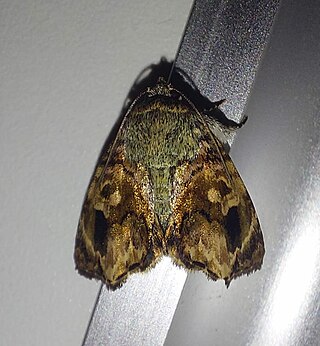Anaulosia is a monotypic moth genus in the subfamily Arctiinae. Its single species, Anaulosia impolita, is found in Costa Rica. Both the genus and species were first described by William Schaus in 1911.
Clemendana is a monotypic moth genus in the subfamily Arctiinae. Its single species, Clemendana pacifera, is found in Brazil. Both the genus and species were first described by William Schaus in 1929.
Upothenia is a monotypic moth genus of the family Erebidae. Its only species, Upothenia acutipennis, is known from Costa Rica. Both the genus and the species were first described by William Schaus, the genus in 1913 and the species one year earlier.
Arpia is a monotypic moth genus of the family Noctuidae. Its only species, Arpia janeira, is found in the Brazilian states of Rio de Janeiro and Espírito Santo. Both the genus and species were first described by William Schaus in 1896.
Chalcoecia is a genus of moths of the family Noctuidae. The genus was erected by George Hampson in 1908.
Concana is a genus of moths of the family Noctuidae. The genus was erected by Francis Walker in 1858.

Cryptochrostis is a genus of moths of the family Erebidae. The genus was erected by Jacob Hübner in 1823.

Drobeta is a genus of moths of the family Noctuidae. The genus was erected by Francis Walker in 1858.
Dyomyx is a genus of moths of the family Erebidae. The genus was erected by Achille Guenée in 1852.

Gonodonta is a genus of moths in the family Erebidae. The genus was erected by Jacob Hübner in 1818.
Hyponeuma is a monotypic moth genus of the family Erebidae. Its only species, Hyponeuma taltula, is found in the Brazilian states of São Paulo and Paraná. Both the genus and species were first described by William Schaus, the genus in 1906 and the species two years earlier.
Lambana is a genus of moths of the family Noctuidae. The genus was erected by Francis Walker in 1866.

Leucosigma is a genus of moths of the family Noctuidae. The genus was erected by Herbert Druce in 1908.
Micrantha is a genus of moths of the family Noctuidae. The genus was erected by George Hampson in 1910.
Neocodia is a genus of moths of the family Noctuidae. The genus was described by William Schaus in 1911.
Polygoniodes is a genus of moths of the family Erebidae. The genus was erected by George Hampson in 1926.
Pseudbarydia is a genus of moths of the family Erebidae. The genus was erected by George Hampson in 1924.
Trogoblemma is a genus of moths of the family Noctuidae. The genus was erected by George Hampson in 1910.
Tyrissa is a genus of moths in the family Erebidae. The genus was erected by Francis Walker in 1866.
Psychidocossus is a monotypic moth genus in the family Cossidae described by David Stephen Fletcher in 1982. Its one species, Psychidocossus infantilis, described by William Schaus in 1911, is found in Costa Rica.



